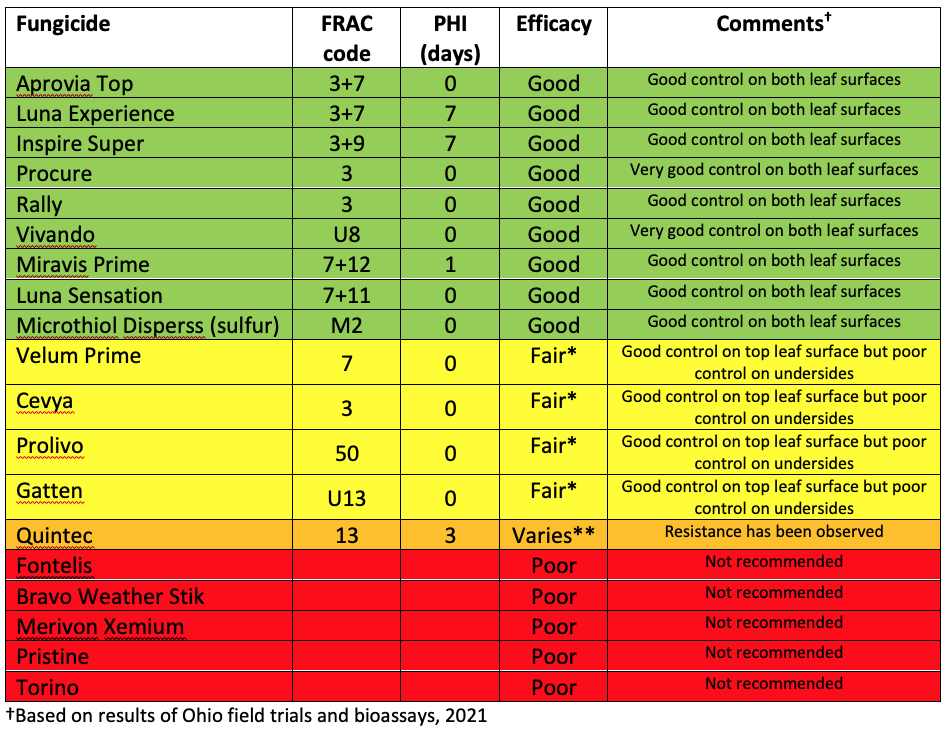
Powdery mildew colonies on the underside of a pumpkin leaf. Fungicide applications should start when these colonies are first observed during scouting. It is important to check both surfaces of the leaves. Photo by Josh Amrhein.
[Updated from 2022 post] Powdery mildew usually appears on pumpkins and other cucurbits in Ohio beginning in early July, but this year it appears to have come in a little later. The pathogen, Psudoperonospora cubensis, does not overwinter in Ohio; infections result from spores blown into the area on the wind. Powdery mildew is favored by moderate to high temperatures and high humidity. However, unlike most other fungal plant pathogens, it is inhibited by free moisture on the leaf surface. Scouts observed a small number of powdery mildew colonies about 2 weeks ago on squash in our downy mildew sentinel plot at OSU’s North Central Agricultural Research Station in Fremont.
Signs of infection are small circular powdery growths on either side of the leaf. These spots enlarge and can eventually cover most of the leaf surface and kill the leaves. Stems and leaf petioles are also susceptible, but the disease is not observed on fruit. In pumpkins, powdery mildew may also attack the “handles”, which can be further damaged by secondary pathogens.
Powdery mildew is managed using disease-resistant varieties and fungicides. Pumpkin and squash varieties vary in resistance to powdery mildew; in general, the more susceptible the variety, the more fungicide needed. The choice of fungicide is important because insensitivity to overused fungicides is common. It is critical that a fungicide resistance management program is followed. Alternate fungicides in different FRAC (Fungicide Resistance Action Committee) groups, indicating different modes of action against the fungus. Fungicide applications should begin when the disease first appears and incidence is low (rule of thumb: at least one leaf of 50 scouted). Fungicides that are labeled for use against cucurbit powdery mildew can be found in the searchable Midwest Vegetable Production Guide for Commercial Growers.
OSU evaluations of efficacy of powdery mildew fungicides in Ohio in 2021 indicated that Aprovia Top, Luna Experience, Inspire Super, Rally, Miravis Prime, Luna Sensation, Microthiol Disperss, Vivando and Procure provided very good control of powdery mildew on pumpkins (see table in color below). Velum Prime, Cevya, Prolivo and Gatten provided good control of powdery mildew on upper leaf surfaces but poor control on the lower surfaces.
Quintec provided good control in 2021 but in other years and other states has failed due to resistance. Fontelis, Bravo Weather Stik, Merivon Xemium, Pristine, and Torino have been shown to provide poor or variable control in Ohio or other states and are not recommended.

Jim Jasinski, OSU Extension, has been running field trials in central Ohio for many years to assess fungicide efficacy against powdery mildew on pumpkins. Some effective fungicide combinations, based on 2021 and 2022 data, are shown in the second table. Some of these fungicides were not effective in our bioassays (table in color), but when paired a broad spectrum protectant like Manzate may prove more effective than when applied alone. Most experts suggest adding a broad spectrum protectant fungicide like Manzate to more powdery mildew-targeted fungicides to reduce the risk of fungicide development, boost fungicide efficacy and protect the crop from other diseases.
Former Buckeye Dr. Andy Wyenandt (Rutgers Univ.) has suggested that spray programs for cucurbit powdery mildew should contain multiple fungicides with different modes of action/FRAC numbers. He suggest a schedule of A-B-C-D-A-B-C-D where A, B, C, and D represent fungicides from different FRAC groups applied at weekly intervals. A protectant fungicide like Manzate should be tank mixed with the powdery mildew-targeted fungicide. This program is primarily to reduce the risk of resistance to any single fungicide, but it will also provide some cover if the pathogen has come in already resistant to one of the fungicides in the program.
Always check the label for full list of allowed crops and use recommendations and restrictions.
Effective Fungicide Treatments to Control PM in Pumpkin in Ohio in 2021 and 2022.
| Treatment |
Crop |
| Cevya alt. Quintec; all with Manzate Pro-Stick (FRAC 3,13) |
Pumpkin |
| Gatten alt. Quintec; all with Manzate Pro-Stick (FRAC U13, 13) |
Pumpkin |
| Procure + Vacciplant alt. Vivando; all with Manzate Pro-Stick (FRAC 3, 50) |
Pumpkin |
| Cevya alt. Merivon; all with Manzate Pro-Stick (FRAC 3, 11,7) |
Pumpkin |
| Gatten alt. Merivon; all with Manzate Pro-Stick (FRAC U13, 11,7) |
Pumpkin |
| Procure alt. Quintec; all with Manzate Pro-Stick (FRAC 3,13) |
Pumpkin |
| Procure alt. Vivando; all with Manzate Pro-Stick (FRAC 3, 50) |
Pumpkin |
| Inspire Super* (FRAC 3,9) |
Pumpkin |
| Aprovia Top* (FRAC 7,3) |
Pumpkin |
*sequential applications for research only, must be rotated per label for grower use.


















